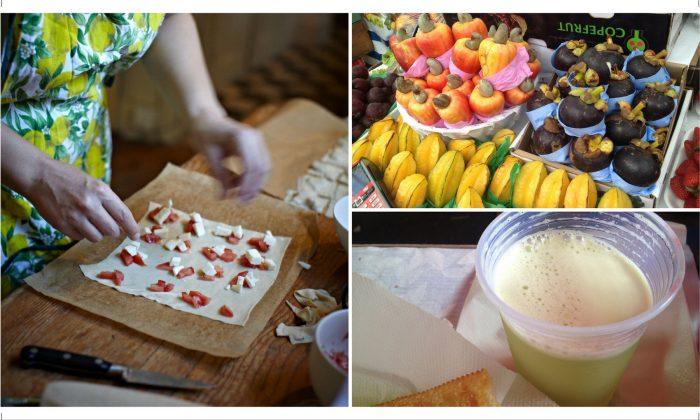LONDON, UK—Think Rio and you may imagine Olympic fervour, the vibrancy of carnival – never Catford. But knock on a certain green door and Londoner Renata Oliveira introduces our senses to the colourful cuisine of her Brazilian homeland. Here she shares recipes and stories of her heritage; it’s an invitation for you to entertain and recreate Brazil at home, South London style.
Take an early morning walk in the streets of Rio or São Paulo and food is what you find – whether it’s the neighbourhood market or the Portuguese influenced bakery. On every street corner there is freshly baked bread to be bought for breakfast, buttered, grilled, and served with fresh orange juice and coffee to builders, maids, and professionals alike. Food here is a social equaliser, and an experience not to be missed.
You will also discover the unexpected – where avocado is used not as a savoury but smashed as a simple dessert with sugar. Vanilla, coffee or carrot cakes are made for breakfast and locals think nothing of sending children to school with a flask of coffee and milk. It’s just how things are done around here.
Renata hails from Brazil’s youngest city São Paulo, the second largest city in the world. She speaks of happy childhood memories dished up with lashings of Nonna’s north Italian oxtail and polenta, and of endless Sunday family road trips, driven miles out of São Paulo by her dad to hunt for the newest restaurant openings, of which there were many.
Authentic Brazilian food: from fried ants to feijoado
Brazilian cuisine is difficult to pinpoint: it’s as immense and diverse as its physical landscape. Early Portuguese and African settlers added their influence to indigenous dishes and ingredients, with new world and ethnic communities adding a myriad more.
Backgrounds aside, ask any Brazilian their national dish and all agree its feijoado, a black bean pork stew similar to French cassoulet, accompanied by kale fried in garlic and, of course rice. Feijoado’s origin tells of a survival stew, said to have been concocted by slaves on their journey from Africa where they were thrown scraps of meat such as offal, pigs’ ears, and tails. An authentic feijoado consists of some nice cuts of pork and according to Renata, “pigs’ ears, trotters, and tails, which I particularly love, but foreign people tend to think of as a bit disgusting”.
Rice and beans are everyday sustenance eaten for lunch and dinner with salad, vegetables, and an additional protein of chicken or beef. Meat is carved in a distinct Brazilian style; the picanha steak is one example. Everyday fruits such as banana, papaya, guava, cocoa, jabuticaba, mangosteen, and cashew are available and sometimes blended with milk. High in vitamin C, cashew fruit (not the nut) is a refreshing recent addition to traditional caipirinha instead of lime.
Caipirinha’s base is the abundantly cheap sugarcane spirit cachaça. Brazilians substitute it with vodka in their caipirinha for a more indulgent drink coined caipiroska; they'd surely smile if they learnt of the gentrification of their humble cachaça in London establishments.
Pastels prepared at the nearest market remain Renata’s favourite thing in the world to eat. She’s not alone; crowds wait patiently for these deep fried pastry pillows of melted cheese and tomato washed down with fresh garapa (sugar cane juice). Pastel pastry is similar to spring rolls – a reflection of the stallholder’s Japanese descent. Each ingredient in Brazilian dishes seems to hold the heritage of the hands that cook them.
Real Brasil in your home
Forget papayas! Renata is vehement they’re rotten or under ripe here, but local London supermarkets do now stock Brazilian staples. Even tapioca starch, a once elusive ingredient for Brazilian ex-pats, can now be found on our shelves.
Renata recounts a trip to Selfridges food hall where the butcher asked her where she was from. “As soon as I said Brazil he said, ‘You’re not here to tell me you want picanha are you?’” If you have meat in mind, do source the Brazilian butchery experience; many Brazilians won’t do a barbeque unless they source picanha, much is their love for this meat.
It’s somewhat absurd to suggest Brazil can be recreated here – sourcing the ingredients is easy, but to recreate the atmosphere is impossible as it’s in the bones and bedrock of the place. Spending a whole Sunday around the table with friends, family, and food celebrated in an everyday way is a start.
And that true native cuisine? Fried ants are on the menu again, perhaps they never left, but Renata observes the recent shift to rediscover indigenous food. It’s what celebrated São Paulo chef Alex Atala is internationally known and recognised for. His restaurant D.O.M. listed as number 11 in The World’s 50 Best Restaurants 2016. Atala’s approach is socially responsible and modern, combining European techniques and philanthropy with anthropologic sensitivity. To summarise Brazilian taste in his words seems apt: “If I tell you mozzarella tastes of Italy and miso speaks of Japan, then tucupi [fermented manioc juice] and ants are the taste of Brazil,” he told The Guardian.
Renata Oliveira divides her time between work, the kitchen, and taking as many foodie holidays as possible. She previously ran the successful sold-out ‘The Green Door Supper Club’. Find her food at www.thehungrylarder.com
Brazilian recipes to try
Bolo de cenoura Brazilian carrot cake ingredients
- 230 g chopped carrots (roughly 2 cm/1 in).
- 230 ml (1 cup) corn oil
- 2 eggs
- 280 g (1¼ cups) caster sugar
- 300 g (2 cups) plain white flour
- 1 tbsp baking powder
- ½ tsp fine salt
Directions
- Grease and flour a 20 x 30 cm (8 x 12 inch) baking tray.
- Preheat oven to 180C (350F).
- In a large bowl mix the flour, baking powder, and salt.
- Use a blender to liquidise the carrots, oil, eggs, and sugar until completely smooth.
- Gently add the liquidised carrots to the flour mix and use a whisk to bind, but don’t beat.
- Pour the dough into the prepared tin and bake for approximately 30 minutes or until a toothpick comes out clean.
- Remove from oven and cool in the tin for 20 to 30 minutes. Gently transfer onto a plate and glaze while still warm.
Chocolate glaze ingredients
- 225 g (1 cup) caster sugar
- 4 tbsp unsalted butter
- 5–6 tbsp milk, preferably full fat
- 4 tbsp good quality cocoa powder
- 1 tsp vanilla extract
Directions
- Place all ingredients in a small saucepan, mix well on a gentle heat and bring to the boil. Allow to boil for a minute or so.
- While the cake is warm, prick the surface with a fork or toothpick. Slowly drizzle half the glaze over the warm cake and allow it to sink in.
- Leave the remaining glaze to cool and thicken slightly to a spread-like consistency (about 5 minutes). Spread on the cake so it forms a thin layer.
- As the cake cools, the glaze will form a very thin and satisfying crust on it, similar to a lemon drizzle cake but less subtle. It’s at its best the next day.
Pao de queijo cheese bread ingredients
The raw dough (already shaped into individual breads) freezes well. Bake 20–25 minutes from frozen.
- 375 ml (1½ cups) full fat milk
- 115 ml (½ cup) vegetable oil
- 1 tbsp salt
- 150 g grated parmesan
- 200 g feta
- 2 eggs
- 3 cups (450 g) cassava starch (sold in Brazilian shops as polvilho azedo, or by UK brands such as Organic Goddess as cassava flour)
Directions
- Preheat oven to 180C.
- Line a baking tray with baking paper/silicon mat.
- Add oil and milk to a small saucepan and bring it to the boil. Remove from the heat as soon as it reaches boiling point.
- In a large bowl, add the flour and salt. Slowly pour the boiling milk/oil mix so it covers the whole surface of the flour and leave for 1 minute.
- Mix well with a wooden spoon. This is a bit of hard work. If you have a stand mixer use the bread mixer attachment, and mix on medium for about 3 minutes until you end up with heavy sticky dough.
- Add the eggs one at a time and continue mixing on medium for about 5 minutes.
- Switch the mixer off, crumble in the cheese and salt, and mix it with your hands or a wooden spoon until completely incorporated. It will be very sticky but don’t add more flour.
- Use two spoons to form small rolls and bake them for 15 to 20 minutes until golden. The bread should be just firm and slightly crispy outside, and chewy on the inside.
- Leave it for 5 minutes to cool a little before serving. Do not serve cold. You really should only eat pao de queijo fresh out of the oven.
Brigadeiros Chocolate Truffles Ingredients
- 1 tin condensed milk
- ½ measure of the same tin full fat milk
- 1 tbsp unsalted butter
- 6 tbsp cocoa powder
- 1 tsp vanilla extract
- A small bowl of chocolate sprinkles
Directions
- In a medium saucepan add the condensed milk, milk and butter.
- Mix on a low-medium heat until the butter is melted.
- Turn the heat to low and gradually add the chocolate powder using a whisk to ensure its fully combined with no lumps.
- Continue to stir with a wooden spoon for 15 to 20 minutes on low-medium heat (low is best if you’re patient enough) until it resembles a very thick caramel consistency and you can see the bottom of the pan.
- Remove from the heat pour into a large bowl well greased with unsalted butter.
- Leave to cool completely. Now the messy part:
- Have a small bowl with the chocolate sprinkles ready.
- Grease your hands with butter.
- Roll small truffle-like chocolate rounds with your hands and roll them in the chocolate sprinkles.
- Place each truffle inside a petit-four case.
Bolinho de Peixe Coriander and Chickpea Flour Fishcakes Ingredients
- 500g white fish: I used tilapia – cod, sea bass or any white fish also works
- 2 eggs
- 3/4 of a tin unsweetened coconut milk (300ml or 1 1/2 cups)
- Couple of handfuls of fresh chopped coriander and parsley or more according to taste. Don’t be too precious about removing the stalks; they taste good and add a nice crunch.
- 1 to 2 tbsp fresh ginger, very finely chopped.
- salt and black pepper
- 1 chopped onion
- 3 spring onions, finely chopped, leaves included
- 1 finely chopped green pepper
- 130 g (1 cup) all purpose flour. You may need to add a bit more or less to reach the right dropping consistency
- 50 g (1/2 cup) chickpea flour
- 1 teaspoon baking powder
- 1 tbsp extra virgin olive oil
- vegetable oil to fry (I used sunflower oil): enough to fill a large frying pan 2 inches high.
- one lime or lemon
Directions
- In a big bowl marinade the raw fish in the herbs, onions, spring onions and ginger. Add salt and pepper to taste. Leave for 5 minutes or more.
- In a large frying pan warm 2 tbsp of olive oil. Tap the fish pieces clear of the herbs and onions (its fine if some remain) and fry on a medium-low heat. Cover and leave until all the fish is just cooked.
- Remove from the heat and transfer to a blender.
- Add to the blender: the eggs, green pepper, coconut milk, and all the marinade ingredients that were left in the bowl.
- Blend enough so it turns into a thick paste but still has some bits in it. (baby food consistency).
- Turn the paste into the bowl and gradually add both flours and the baking powder, mixing with a large spoon. Be careful not to add too much flour. The dough should not become thick enough to roll with your hands. It should be of a dropping consistency.
- In a large frying pan heat the oil on a medium heat until it is very hot using a tablespoon gently and carefully drop spoonfuls of the dough into the oil and fry on both sides until golden (about a minute each side).
- Eat them fresh and make sure you eat them with a squeeze of lime or lemon on them – it makes all the difference.







Friends Read Free